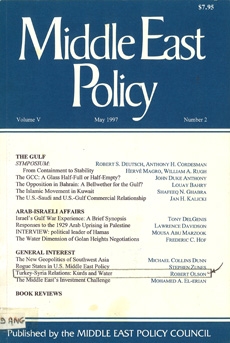|
TURKEY-SYRIA RELATIONS SINCE THE GULF WAR: KURDS AND WATER
Robert Olson
This article will focus on the challenge of Kurdish nationalism within Turkey, particularly as it affects Turkey’s relations with Syria and the distribution of the waters of the Euphrates, Tigris and Asi rivers, with which the “Kurdish problem” is inextricably linked.1
The Kurds are estimated to number some 20-25 million living largely in four Middle East countries: Turkey, with 10-12 million; Iran, with 5-6 million; Iraq, with 3.5 million and Syria, with 1 million. Some 70,000-80,000 Kurds also live in Armenia and in Azerbaijan. Recent reports suggest there are 300,000-1 million Kurds living within the Russian Federation. Since the bulk of Kurds live in contiguous areas, they have possessed a sense of community and shared space since medieval times at least. This sense of identity was reinforced by the a growing sense of nationalism during the last two decades of the nineteenth century. The Kurds consider themselves to be direct descendants of the ancient Medes (although modem scholarship doubts this), who, because of military conquests, defeats and the collapse of empires, began to migrate around 2,000 years ago to the mountain fastnesses where they live today. From these strategic and almost impregnable locations, the Kurds were able to preserve their communities while at the same time participating in the great Armenian, Greek, Byzantine, Arab, Turkish, Iranian and Ottoman empires that dominated the region's history right up to the collapse and partition of the Ottoman Empire at the end of World War I. The Kurds were promised the possibility of an independent state in articles 62 and 64 of the Treaty of Sevres, signed on August 10, 1920.
But there was to be no Kurdish state. The main reason for this was the emergence of a strong Turkish nationalist state in the aftermath of the war and the subsequent suppression of Kurdish nationalist revolts in 1925, 1930 and 1937-38. There was not to be another Kurdish nationalist challenge to the Turkish rule until the emergence of the PKK in the early 1980s and especially after the Gulf War. The Kurdish movement in Iran was also contained by a strong nationalist government in Iran during the inter-war and post-World-War-II periods. The one exception was the brief year in 1946, when the Kurds were able to establish a nationalist government in Mahabad before it fell to the vicissitudes of the emerging Cold War.
It was only in the wake of the 1991 Gulf War that the Kurds in Iraq seemed to have gained an opportunity to establish an independent state or, at least, an autonomous entity federated with the rest of Iraq, as a result of Allied (U.S. and European) policies aimed at defeating Saddam Hussein. The Allied forces supported a Kurdish insurrection against his regime. Its defeat and the subsequent flight of the Kurds to the mountainous regions bordering Iran and, especially, Turkey created further support in the West for some kind of sanctuary for the Kurds in northern Iraq. Of course, the Kurds desired to make this “safe zone” as autonomous as possible. I would argue that the perceived intent of the Kurds to create an independent state in northern Iraq led Turkey and Syria to conclude a series of national security agreements, all of which failed due to differences over the Kurdish question and the water problem.
Turkey’s Relations with Syria
Prior to the Gulf War, Turkey-Syrian relations were dominated by two major concerns. Until 1980, Turkey’s 1939 annexation of Hatay (formerly Alexandretta), made possible by France’s desire to neutralize Turkey’s entrance into World War II, still rankled in Damascus. The second major problem between the two countries was the already growing concern over the distribution of the downflow of the Euphrates from Turkey to Syria. The differences over water grew in the 1970s and 1980s as Turkey continued to build a series of dams and irrigation projects, which it called the South Anatolia Project, generally known by its Turkish acronym GAP (Güney Dogu Projesi). The Keban dam was constructed 1964-74 and the Karakaya dam, 1976-1987; the Ataturk dam and irrigation project is still being completed. During the contraction of the dams, Turkey generally kept the downflow of the Euphrates to Syria at around 500 cubic meters (cm) per second, except during periods when it was filling the dams' reservoirs. During such times, tension generally rose between the two capitals. Another major problem in the late 1960s and 1970s was Syria's policy of granting asylum to Kurdish and Armenian guerrilla groups, both of which the Turks considered to be terrorists.2
In 1980 another development occurred that, in addition to the water question, has continued to dominate relations between the two countries right up to the present. This was Syria's decision to give sanctuary to Abdullah Ocalan, the leader of the Kurdistan Workers' party popularly known by its Kurdish acronym, PKK (Partia Kakaren-i-Kurdistan).3
The PKK is a Kurdish nationalist organization that has its origins in the late 1970s. Relations between the PKK and …
| 